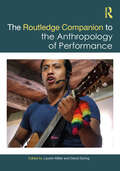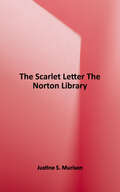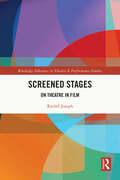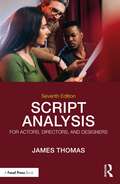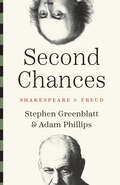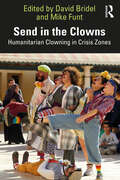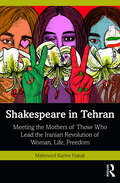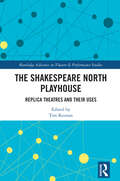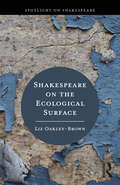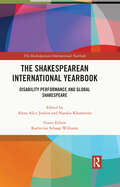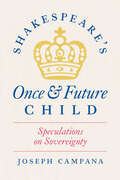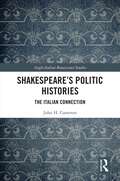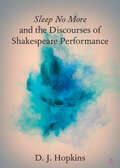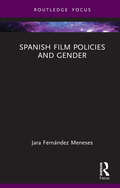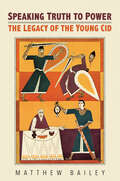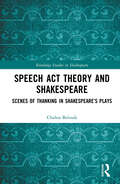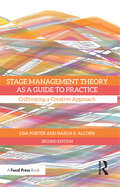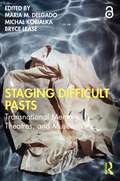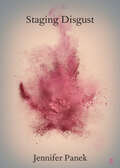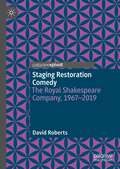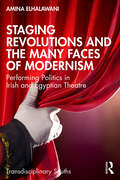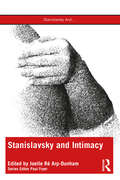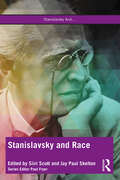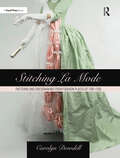- Table View
- List View
The Routledge Companion to the Anthropology of Performance (Routledge Companions)
by Lauren Miller David SyringThe Routledge Companion to the Anthropology of Performance provides a cutting-edge, comprehensive overview of the foundations, epistemologies, methodologies, key topics and current debates, and future directions in the field. It brings together work from the disciplines of anthropology and performance studies, as well as adjacent fields. Across 31 chapters, a diverse range of international scholars cover topics including: Ritual Theater Storytelling Music Dance Textiles Land Acknowledgments Indigenous Identity Visual Arts Embodiment Cognition Healing Festivals Politics Activism The Law Race and Ethnicity Gender and Sexuality Class Religion, Spirituality, and Faith Disability Leisure, Gaming, and Sport In addition, the included Appendix offers tools, exercises, and activities designed by contributors as useful suggestions to readers, both within and beyond academic contexts, to take the insights of performance anthropology into their work. This is a valuable reference for scholars and upper-level students in anthropology, performance studies, and related disciplines, including religious studies, art, philosophy, history, political science, gender studies, and education.
The Scarlet Letter (The Norton Library)
by Nathaniel. Hawthorne Justine S. MurisonOne of the most influential novels in American literature, The Scarlet Letter is the story of a Puritan woman who conceives a child through an affair and her subsequent struggle to overcome sin, shame, and social stigma. Edited by Justine S. Murison, the Norton Library edition features the text of the third (1850) edition of the novel, with explanatory endnotes and an introduction that situates the work in its historical and literary contexts.
Screened Stages: On Theatre in Film (ISSN)
by Rachel JosephThis book is devoted to tracing the variety of ways that theatre, theatricality, and performance are embedded in Hollywood cinema as screened stages.A screened stage is the literal or metaphorical appearance of a stage on screen. When the Hollywood style emerged in cinema history it traumatically severed the entwined relationship between film and theatre. The book makes the argument that cinema longs for theatre after that separation. The histories of stage and screen persistently crisscross one another making their separation problematic. The screened stage from the end of the nineteenth century until now offers a miniaturized version of cinema and theatre history. Moments of the stage within the screen compress historical styles and movements into saturated representations on film. Such examples overflow the cinematic screen into singular manifestations of presentness. Screened stages uncover what it means to be simultaneously present and absent.This book would be of great interest to students and scholars of theatre, film, dance, and performance.
Script Analysis for Actors, Directors, and Designers
by James ThomasScript Analysis for Actors, Directors, and Designers, Seventh Edition, teaches the skills of script analysis using a formalist approach that examines the written part of a play to evaluate its potentials for performance and production. This new edition features new and revised content, including an analysis of two new plays, Kalidasa’s Shakuntala and Federico Garcia Lorca’s The House of Bernarda Alba; information for the theatre designer integrated in chapters throughout the book; and an expanded appendix on critical approaches to script analysis. Explorations of both classic and unconventional plays are combined with clear examples, end-of-chapter summaries, and stimulating questions that will allow actors, directors, and designers to immediately incorporate the concepts and processes into their theatre production work. An excellent resource for students of acting, script analysis, directing, playwriting, and stage design courses, this book provides the tools to effectively bring a script to life on stage.
Second Chances: Shakespeare and Freud (The Anthony Hecht Lectures in the Humanities Series)
by Stephen Greenblatt Adam PhillipsA powerful exploration of the human capacity for renewal, as seen through Shakespeare and Freud In this fresh investigation, Stephen Greenblatt and Adam Phillips explore how the second chance has been an essential feature of the literary imagination and a promise so central to our existence that we try to reproduce it again and again. Innumerable stories, from the Homeric epics to the New Testament, and from Oedipus Rex to Hamlet, explore the realization or failure of second chances—outcomes that depend on accident, acts of will, or fate. Such stories let us repeatedly rehearse the experience of loss and recovery: to know the joy that comes with a renewal of love and pleasure and to face the pain that comes with realizing that some damage can never be undone. Through a series of illuminating readings, the authors show how Shakespeare was the supreme virtuoso of the second chance and Freud was its supreme interpreter. Both Shakespeare and Freud believed that we can narrate our life stories as tales of transformation, of momentous shifts, constrained by time and place but often still possible. Ranging from The Comedy of Errors to The Winter&’s Tale, and from D. W. Winnicott to Marcel Proust, the authors challenge readers to imagine how, as Phillips writes, &“it is the mending that matters.&”
Send in the Clowns: Humanitarian Clowning in Crisis Zones
by David Bridel Mike FuntSend in the Clowns presents interviews with twenty-four pioneering humanitarian and activist clowns and thought leaders working in hospitals, refugee camps, orphanages and war zones, and at the sites of street protests and locations of social unrest across the world.This book is built around interviews with some of the world’s leading practitioners of clowning for change, justice, and health outside of the entertainment mainstream, featuring artists and organizations including Patch Adams (US), the Dream Doctors Project (Israel), Clown Me In (Lebanon), and Doutores da Alegria (Brazil). Situating the topic in relation to indigenous and ritual clowning, investigating the various functions of the clown in early societies, and centering the discourse around interviews with key practitioners, the book explores a wide range of clown applications across the globe. This includes the special significance of the clown archetype in socially, politically, and culturally challenging situations, the successes and challenges of the art activists who are at the forefront of this movement, and the modern humanitarian clown’s relationship to original forms of clowning that can be traced back through history.This is a vital resource for anyone studying, teaching, or practicing clown work in applied contexts, from health care to conflict resolution.
Shakespeare in Tehran: Meeting the Mothers of Those Who Lead the Iranian Revolution of Woman, Life, Freedom
by Mahmood Karimi HakakShakespeare in Tehran is a personal history of Iran through the eyes of an award-winning Iranian American artist. Drawing on parallels between life and the stage, it uses A Midsummer Night’s Dream as a roadmap to explore social, political, economic, and cultural aspects of Iran before and after the revolution of 1979. Through first-person accounts, interspersed with emotional reflections of the universal human experience, it delves into the historical and sociological context of a divided country. Storytelling, flashbacks, and flashforwards paint an intimate picture of public life in Iran in a time of uncertainty. Accessible, engaging, and nuanced, this volume will be of interest to scholars and researchers of politics, history, theater and performance studies, and West Asian studies.
The Shakespeare North Playhouse: Replica Theatres and Their Uses (ISSN)
by Tim KeenanThis collection celebrates the opening of the Shakespeare North Playhouse (SNP). After discussion of its genesis and development by four people pivotal to its progress at different stages of the project, this book explores different aspects of the SNP’s purpose and functions across three broad categories: buildings and spaces, practices and performance, and community arts and education. Various chapters offer answers to fundamental questions about replica theatres, including: Why do we build them? What do they do? How do we use them? In the course of these discussions, the purposes, potential, and programming of the SNP are discussed in relation to other Globe-type replicas in the UK and beyond. Contributors to this collection analyse key academic and practice-based concerns within their fields of expertise connected to the use (and misuse) of replica theatres to suggest the ways in which they can be used to drive research and practice in contemporary Shakespearean performance, connect with young people, and serve local communities.This book will appeal to academics, students, and practitioners interested in historical and contemporary approaches to Shakespeare in the fields covered. It should also appeal to general readers with an interest in the topics, particularly in Merseyside and the North-West region.
Shakespeare on the Ecological Surface (Spotlight on Shakespeare)
by Liz Oakley-BrownShakespeare on the Ecological Surface uses the concept of the ‘surface’ to examine the relationship between contemporary performance and ecocriticism. Each section looks, in turn, at the 'surfaces' of slick, smoke, sky, steam, soil, slime, snail, silk, skin and stage to build connections between ecocriticism, activism, critical theory, Shakespeare and performance. While the word ‘surface’ was never used in Shakespeare’s works, Liz Oakley-Brown shows how thinking about Shakespearean surfaces helps readers explore the politics of Elizabethan and Jacobean culture. She also draws surprising parallels with our current political and ecological concerns. The book explores how Shakespeare uses ecological surfaces to help understand other types of surfaces in his plays and poems: characters’ public-facing selves; contact zones between characters and the natural world; surfaces upon which words are written; and physical surfaces upon which plays are staged. This book will be an illuminating read for anyone studying Shakespeare, early modern culture, ecocriticism, performance and activism.
The Shakespearean International Yearbook: Disability Performance and Global Shakespeare (The Shakespearean International Yearbook)
by Alexa Alice Joubin Natalia Khomenko Katherine Schaap WilliamsThe Shakespearean International Yearbook surveys the present state of Shakespeare studies in global contexts, addressing issues that are fundamental to our interpretive encounter with Shakespeare’s work and his time. Contributions are solicited from scholars across the field and from both hemispheres of the globe who represent diverse career stages and linguistic traditions. Both new and ongoing trends are examined in comparative contexts, and emerging voices in different cultural contexts are featured alongside established scholarship. Each volume features a collection of articles that focus on a theme curated by a specialist Guest Editor, along with coverage of the current state of the field in other aspects. An essential reference tool for scholars of early modern literature and culture, this annual publication captures, from year to year, current and developing thought in global Shakespeare scholarship and performance practice worldwide.
Shakespeare's Once and Future Child: Speculations on Sovereignty
by Joseph CampanaA study of Shakespeare’s child figures in relation to their own political moment, as well as our own. Politicians are fond of saying that “children are the future.” How did the child become a figure for our political hopes? Joseph Campana’s book locates the source of this idea in transformations of childhood and political sovereignty during the age of Shakespeare, changes spectacularly dramatized by the playwright himself. Shakespeare’s works feature far more child figures—and more politically entangled children—than other literary or theatrical works of the era. Campana delves into this rich corpus to show how children and childhood expose assumptions about the shape of an ideal polity, the nature of citizenship, the growing importance of population and demographics, and the question of what is or is not human. As our ability to imagine viable futures on our planet feels ever more limited, and as children take up legal proceedings to sue on behalf of the future, it behooves us to understand the way past child figures haunt our conversations about intergenerational justice. Shakespeare offers critical precedents for questions we still struggle to answer.
Shakespeare’s Politic Histories: The Italian Connection (Anglo-Italian Renaissance Studies)
by John H. CameronThis book argues that Shakespeare's first tetralogy is informed by the Italian ‘politic histories’ of the early modern period, those works of history, inspired by the Roman historian Tacitus, that sought to explore the machinations of power politics in governance and in the shaping of historical events; that a close reading of these Italian ‘politic histories’ will greatly aid our understanding of the ‘politic’ qualities dramatized in Shakespeare’s early English History plays; that the writings of Niccolò Machiavelli in particular will likewise aid to such understanding; that these ‘politic histories’ were available (in a variety of forms) to many English early modern writers, Shakespeare included, and are thus helpful as grounds for political and strategic analogy and for informing our reading of Shakespeare's politic histories. While a reading of the Italian ‘politic’ historians can aid in our understanding of Shakespeare’s achievement, we should regard the English History plays as ‘politic histories’ in their own right, i.e. as dramatized versions of precisely the same kinds of ‘politic’ historical writing, with its emphasis on ragion di Stato or raison d’état. This emphasis on what the Elizabethans called ‘stratagems’ suggests new ways to read the plays and to interpret the motivation and action of its characters, ways that challenge some of our more established reading of the plays’ ‘Machiavellian’ characters (particularly Richard III) and suggest far greater strategic acumen on the part of previously overlooked characters (particularly Buckingham and Stanley), providing new ways to read the Shakespeare's politic histories and to better appreciate their Italian connection.
Sleep No More and the Discourses of Shakespeare Performance (Elements in Shakespeare Performance)
by null D. J. HopkinsThis Element focuses on Sleep No More, theatre adaptation of Macbeth produced by the British company Punchdrunk. This Element frames the Shakespeare adaptation as part of a system of ghostly citationality through which audiences understand the significance of the past in performances today. Hopkins introduces the concept of “uncanny spectatorship” to describe audience practice in Sleep No More and other performance contexts. The Element positions experiences like Sleep No More as forms of critical inquiry, and, despite its seemingly analog format, Sleep No More is discussed as a valuable site for media research. Ultimately, Sleep No More and the Discourses of Shakespeare Performance Sleep No More offers an opportunity to explore a set of concepts that are significant to the subject of Shakespeare Performance and to consider the ways in which audiences interact with bodies, spaces, text, and media.
Spanish Film Policies and Gender (Routledge Focus on Media and Cultural Studies)
by Jara Fernández MenesesThis book provides a comprehensive cultural and historical account of the key film policies put into place by the Spanish state between 1980 and 2010 through a gendered lens, framing these policies within the wider context of European film legislation.Departing from the belief that there is no such thing as an objective and value-neutral approach to policy analysis because our society is organised around gender, this volume builds upon Pierre Bourdieu’s theory of field to propose that film policies do not emerge in a vacuum because they respond to different demands from those agents involved in the field of the Spanish cinema. By so doing, it critically assesses how these policies have come into being, by whom, in response to what interests, how they have shaped the Spanish film industry, and how far and in what ways they have tackled gender inequality in the Spanish film industry.This book will be of great interest to scholars and students of Spanish cinema, gender studies, film industry studies, film policy, and feminist film studies.
Sparkles, No Sparkles
by Shannon McNeillAdorable animals go for a glittering night at the theater in this hilarious picture book, a perfect read-aloud tale for very young readers.A frog has no sparkle.A poodle has no sparkle.A pigeon has no sparkle.Not to worry! A cape has sparkle, a crown has sparkle and boots have sparkle.Some wily animals decide to hit the stage, leaving the actors without costumes. After the animals get their moment in the spotlight, chaos ensues . . . but luckily there are some chicks with sparkle to save the day.
Speaking Truth to Power: The Legacy of the Young Cid (Toronto Iberic #86)
by Matthew BaileyEmerging from a richly diverse oral narrative tradition, the heroic tale of the young Cid appears in multiple textual manifestations. From its first appearance circa 1300, the dynamic narrative of the legendary deeds of this young Castilian warrior eclipses the uninspired, matter-of-fact narration of the reign of Fernando I into which it is incorporated. In its analysis of the Mocedades de Rodrigo, the epic poem of Cid’s youth, Speaking Truth to Power identifies the narrative cohesion and the aesthetic principles that elevated the story of the young Cid to its place of prominence among the epic narratives of medieval Spain. Examining the evolution of the narrative through various textual versions, Matthew Bailey highlights the permutations that propelled the young Cid’s unparalleled popularity. The book traces this vibrant narrative tradition from its earliest manifestation in the aftermath of Charlemagne’s imperial mission in Spain to the early modern drama of Guillén de Castro. It convincingly discerns the leadership qualities and the social impact of its legendary protagonists, from their manifestation in the Latin chronicles of early Iberia through the Renaissance, incorporating a wealth of previous scholarship in its innovative findings. Speaking Truth to Power provides readers with a heightened appreciation for the vibrancy of the poetic tradition that lives beyond the texts we study, the oral narratives that are continually refashioned for new audiences and contexts.
Speech Act Theory and Shakespeare: Scenes of Thanking in Shakespeare’s Plays (Routledge Studies in Shakespeare)
by Chahra BeloufaSpeech Act Theory and Shakespeare delves deeper than linguistic ornamentation to illuminate the complex dynamics of thanking as a significant speech act in Shakespearean plays. The word “thanks” appears nearly 400 times in 37 Shakespearean plays, calling for a careful investigation of its veracity as a speech act in the 16th-century setting. This volume combines linguistic analysis to explore the various uses of thanks, focusing on key thanking scenes across a spectrum of plays, including All’s Well That Ends Well, Romeo and Juliet, The Merchant of Venice, Timon of Athens, The Winter’s Tale, and the Henriad. Shakespeare’s works indicate the act of thanking to be more than a normal part of dialogue; it is an artistic expression fraught with pitfalls similar to those of negative speech acts. The study aims to determine what compels the characters in Shakespeare to offer thanks and evaluates Shakespeare’s accomplishment in imbuing the word “thanks” with performance quality in the theatrical sphere. This work adds to our comprehension of Shakespearean plays and larger conversations on the challenges of language usage in theatrical and cultural settings by examining the convergence of gratitude with power dynamics, political intrigue, and interpersonal relationships, drawing on a multidisciplinary approach that includes pragmatics, philosophy, religion, and psychology.
Stage Management Theory as a Guide to Practice: Cultivating a Creative Approach
by Lisa Porter Narda E. AlcornStage Management Theory as a Guide to Practice, Second Edition offers theory and methodology for developing a unique and inclusive stage management style, preparing stage managers to develop an adaptive approach for the vast and varied scope of the production process, forge their own path, and respond to the present moment with care and creativity. This book provides tactile strategies, enabling stage managers to navigate different groups of collaborators, venues, and projects. Experiential stories based on extensive experience with world-renowned artists exemplify the practices and provide frameworks for self-reflection, synthesis, and engagement with theory-guided practice. This book empowers stage managers to guide any collaborative project to fruition by incorporating the "How You" with the "How To." This second edition has been expanded, and includes new experiential stories and a new chapter focused on inclusive processes that can be applied from pre-production through closing, as well as the full text of the HowlRound Theatre essay We Commit to Anti-Racist Stage Management Education. Exploring topics such as group dynamics, ethics, culture, and strategic communication, Stage Management Theory as a Guide to Practice is an essential tool for advanced stage management students, educators, and professionals.
Staging Difficult Pasts: Transnational Memory, Theatres, and Museums
by Maria M. Delgado Michal Kobialka Bryce LeaseThis collection of original essays brings together museum, theatre, and performance case studies with a focus on their distinctive and overlapping modes of producing memory for transnational audiences. Whether this is through narrative, object, embodied encounter or a combination of the three, this volume considers distinctions and interactions between memory and history specifically through the lenses of theatre and performance studies, visual culture, and museum and curator studies. This book is underpinned by three areas of research enquiry: How are contemporary theatre makers and museum curators staging historical narratives of difficult pasts? How might comparisons between theatre and museum practices offer new insights into the role objects play in generating and representing difficult pasts? What points of overlap, comparison, and contrast among these constructions of history and memory of authoritarianism, slavery, colonialism, genocide, armed conflict, fascism, and communism might offer an expanded understanding of difficult pasts in these transnational cultural contexts? This collection is designed for any scholar of its central disciplines, as well as for those interested in cultural geography, memory studies, and postcolonial theory. The Open Access version of this book, available at http://www.taylorfrancis.com, has been made available under a Creative Commons Attribution-NoDerivatives (CC-BY-ND) 4.0 license.
Staging Disgust: Rape, Shame, and Performance in Shakespeare and Middleton (Elements in Shakespeare Performance)
by null Jennifer PanekThis Element turns to the stage to ask a simple question about gender and affect: what causes the shame of the early modern rape victim? Beneath honour codes and problematic assumptions about consent, the answer lies in affect, disgust. It explores both the textual "performance" of affect, how literary language works to evoke emotions and the ways disgust can work in theatrical performance. Here Shakespeare's poem The Rape of Lucrece is the classic paradigm of sexual pollution and shame, where disgust's irrational logic of contamination leaves the raped wife in a permanent state of uncleanness that spreads from body to soul. Staging Disgust offers alternatives to this depressing trajectory: Middleton's Women Beware Women and Shakespeare's Titus Andronicus perform disgust with a difference, deploying the audience's revulsion to challenge the assumption that a raped woman should “naturally” feel intolerable shame.
Staging Restoration Comedy: The Royal Shakespeare Company, 1967-2019
by David RobertsSince its 1967 production of Vanbrugh’s The Relapse, the Royal Shakespeare Company has been the world’s leading producer of Restoration Comedies. This book is the first to document and critique the company’s history of engagement with that repertoire. It reviews the spaces in which productions have been performed, design principles, casting, voicing, textual adaptation, musical direction, actor perspectives, and the problems of how to confront, adopt or depart from received notions of Restoration style. It goes on to posit that, for all the RSC’s explorations of Restoration Comedy, the company has maintained the repertoire as a fringe interest played out in niche spaces, while recycling many of the assumptions it claims to challenge, and that what is needed is the writer-led intervention seen in RSC and National Theatre adaptations of French drama from the same period. Only then can Restoration Comedy begin to engage wider audiences in new sites of political, historical andcultural meaning.
Staging Revolutions and the Many Faces of Modernism: Performing Politics in Irish and Egyptian Theatre (Transdisciplinary Souths)
by Amina ElHalawaniThe book explores how theatre, with its performative capacity, has the power to engage with and affect the politics of its day. It sets the stage for the reader to discover the revolutionary traditions of Egyptian and Irish theatre, very distinct in their histories and cultures, and understand their enduring relevance in today’s world. The volume takes Ireland as a case study of the interplay between cultural nationalism and politically engaged theatre and compares it to the role of the theatre in Egypt during its Golden era in the 1960s.Through a selection of Egyptian plays by Tawfiq al-Hakim, Mikhail Roman, Yusuf Idris, and Salah Abdul-Saboor, alongside Irish plays by Brian Friel, Frank McGuinness, Christina Reid, and Samuel Beckett, it maps the political aesthetics of unsteady times and seemingly disparate places to reflect on the dynamics of revolt as a staged act in and of itself. Further, the book examines how playwrights from both nations have engaged with theatre as a medium, focusing on how their contemplations, hesitations, frustrations, and protest have been translated onto the stage in their various plays, and comprehends the transformative role the theatre has always played in politics in shaping history across time and space.Bridging together discussions on transnational modernisms with nuanced cultural histories of protest, this critical work will be of great interest to scholars and researchers of literary studies, identity politics, cultural studies, theatre and performance studies, and political studies.
Stanislavsky and Intimacy (Stanislavsky And...)
by Arp-Dunham, Joelle RéStanislavsky and Intimacy is the first academic edited book with a focus on how intimacy protocols, choreography, and theories intersect with the broad practices of Konstantin Stanislavsky’s ‘system’. As the basis for most Western theatre and film acting, Stanislavsky’s system centers on truthful performances. Intimacy direction and choreography insists on not only a culture of consent, but also specific, repeatable choreography for all staged intimate moments. These two practices have often been placed as diametric opposites, but this book seeks to dispel this argument. Each chapter discusses specific Stanislavskian principles and practices as they relate to staged sexually intimate moments, also opening the conversation to the broader themes and practices of other kinds of intimacy within the acting field. Stanislavsky And... is a series of multi-perspectival collections that bring the enduring legacy of Stanislavskian actor training into the spotlight of contemporary performance culture, making them ideal for students, teachers, and scholars of acting, actor training, and directing.
Stanislavsky and Race: Questioning the “System” in the 21st Century (Stanislavsky And...)
by Siiri Scott Paul SkeltonStanislavsky and Race is the first book to explore the role that Konstantin Stanislavsky’s “system” and its legacies can play in building, troubling and illuminating today’s anti-racist theatre practices. This collection of essays from leading figures in the field of actor training stands not only as a resource for a new area of academic enquiry, but also for students, actors, directors, teachers and academics who are engaged in making inclusive contemporary theatre. In seeking to dismantle the dogma that surrounds much actor training and replace it with a culturally competent approach that will benefit our entire community, the “system” is approached from a range of perspectives featuring the research, reflections and provocations of 20 different international artists interrogating Stanislavsky’s approach through the lens of race, place and identity. Stanislavsky and … is a series of multi-perspectival collections that bring the enduring legacy of Stanislavskian actor training into the spotlight of contemporary performance culture, making them ideal for students, teachers and scholars of acting, actor training and directing.
Stitching La Mode: Patterns and Dressmaking from Fashion Plates of 1785-1795
by Carolyn DowdellStitching La Mode: Patterns and Dressmaking from Fashion Plates of 1785-1795 brings to life women’s unique and extravagant fashions of 1785-1795 in a beautifully illustrated and accessible way. The book consists of scaled patterns directly based on original French, German and English fashion plates drafted according to period-accurate shapes. The patterns encompass the full look presented in each fashion plate from garments to accessories. These are accompanied by a color image of the corresponding fashion plate, straightforward, illustrated directions for recreating the outfits, information on the material used and modelled reproductions of each plate to demonstrate what they would look like in "real life". The book focuses on unique styles often seen in fashion plates but rarely – if ever – patterned before, making this a fresh and exciting yet historically accurate take on late eighteenth-century fashion. Stitching La Mode significantly expands the understanding of transitional fashions from the late eighteenth century with concrete, physical examples of styles, perfectly suited for costume technicians and makers, costume historians and hobby costumers and re-enactors.
